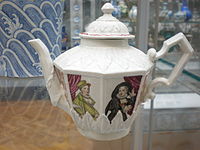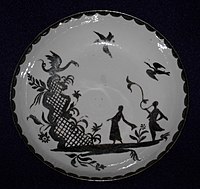Vezzi porcelain

Vezzi porcelain is porcelain made by the Vezzi porcelain factory in Venice, Italy, established in 1720 by the Vezzi family. It was the first porcelain factory in Italy, after the experimental Medici porcelain of the 16th century.[1] It operated only until 1727, so surviving pieces are few, probably fewer than 200. It made "true" hard-paste porcelain, and was only the third factory in Europe to do so, hiring technicians from Meissen porcelain and Vienna porcelain, the first two makers.[2][3]
The great majority of wares are teaware: cups, saucers, teapots and a few small plates. Many cups are beakers without handles, and the teapots, which form an unusually large proportion of the surviving pieces, often have moulded shapes, including
History
Francesco Vezzi (1651–1740) was a
There was to be no more porcelain made in Venice between 1727 and 1758, and only the
-
Teapot with relief and painted decoration
-
Vase
-
Teapot with relief and painted decoration of actresses
-
Teapot with relief and painted decoration
-
Mark with "Vena." for "Venice"
-
Plate (black and white photo)
-
Beaker (other side of one at top)
Notes
- ^ Chaffers, 422; Le Corbellier, 5; Battie, 86–87 on Medici porcelain.
- ^ Le Corbeiller, 6; Battie, 102
- ^ "Teapot, 1720–27, Vezzi Factory", Metropolitan Museum of Art
- ^ Le Corbeiller, 6–7; Battie, 103
- ^ "Teapot and cover". Victoria and Albert Museum. Retrieved June 11, 2019.
- ^ Le Corbeiller, 6; Battie, 103; Favaro, 299
- ISBN 9780195189483– via Oxford Reference.
- ^ Le Corbeiller, 8
- ^ Le Corbeiller, 8; Battie, 103
- ^ Favaro, 290
- ^ Favaro, 291
References
- ISBN 1850292515
- Chaffers, William, Marks and Monograms on Pottery and Porcelain, 1874 edition, online
- Le Corbeiller, Clare, Eighteenth-century Italian Porcelain, 1985, Metropolitan Museum of Art, ISBN 0870994212, 9780870994210, fully online
- Savage, George, and Newman, Harold, An Illustrated Dictionary of Ceramics, 1985, Thames & Hudson, ISBN 0500273804
- Favaro, Giovanni, "Old and New Ceramics", in Lanaro, Paola (ed), At the Centre of the Old World: Trade and Manufacturing in Venice and on the Venetian Mainland (1400–1800), 2006, Centre for Reformation and Renaissance Studies, Victoria University (Toronto, Ont.), ISBN 0772720312, 9780772720313, google books







